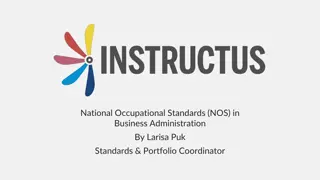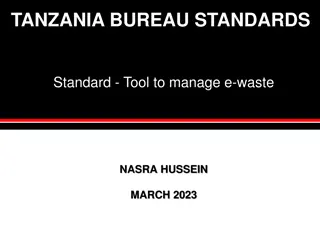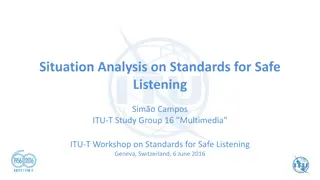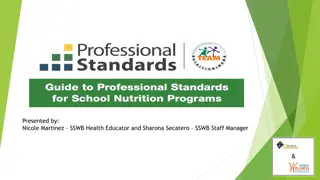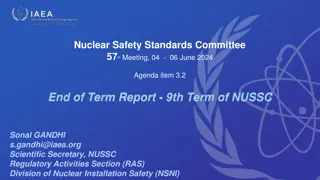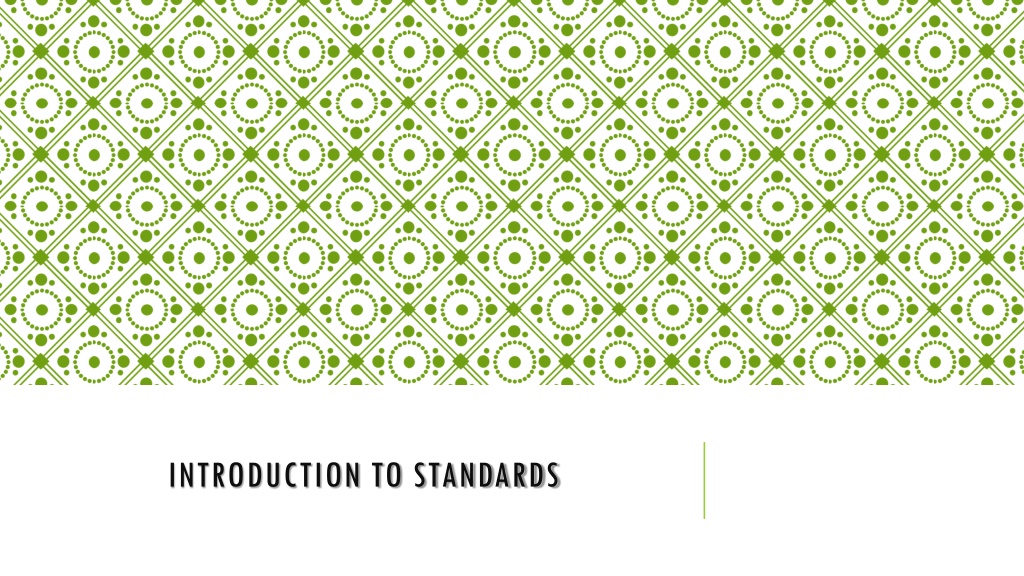
Understanding the Role of Standards in Daily Life
Discover the significance of standards in daily life, from ensuring product safety to facilitating communication and trade. Explore the definition of standards, their importance, benefits, and impact on various aspects of society.
Uploaded on | 0 Views
Download Presentation

Please find below an Image/Link to download the presentation.
The content on the website is provided AS IS for your information and personal use only. It may not be sold, licensed, or shared on other websites without obtaining consent from the author. If you encounter any issues during the download, it is possible that the publisher has removed the file from their server.
You are allowed to download the files provided on this website for personal or commercial use, subject to the condition that they are used lawfully. All files are the property of their respective owners.
The content on the website is provided AS IS for your information and personal use only. It may not be sold, licensed, or shared on other websites without obtaining consent from the author.
E N D
Presentation Transcript
STANDARDS A LIFE SAVER! WHAT IS A STANDARD?
DEFINITION A standard is a document, established by consensus that provides rules, guidelines or characteristics for activities or their results. (ISO/IEC Guide 2:2004) (American National Standards Institute)
DEFINITION (CONTD) Standards are published documents setting out specifications and procedures designed to ensure products, services and systems are safe, reliable and consistently perform the way they were intended to. They establish a common language which defines quality and safety criteria. (STANDARDS Australia, www.standards.org.au/standardsdevelopment/what_is_a_standard/Pages/default.aspx)
DEFINITION (CONTD) Written definition, limit, or rule, approved and monitored for compliance by an authoritative agency or professional or recognized body as a minimum acceptable benchmark. (BusinessDictionary.com)
STANDARDS IN DAILY LIFE Standards play an important role in everyday life. They may establish size or shape or capacity of a product, process or system. They can specify performance of products or personnel. They also can define terms so that there is no misunderstanding among those using the standard. As examples, standards help ensure that film to fit our cameras can be purchased anywhere in the world, that a light bulb fits a socket, and plugs for electrical appliances fit outlets. With standards, our homes, workplaces and public buildings are safer from collapse, fire and explosion. (American National Standards Institute, www.ansi.org/about_ansi/faqs/faqs.aspx?menuid=1)
THE IMPORTANCE OF STANDARDS Standards provide people and organizations with a basis for mutual understanding, and are used as tools to facilitate communication, measurement, commerce and manufacturing. (European Committee for Electrotechnical Standardization, www.cencenelec.eu/research/tools/Pages/default.aspx)
THE BENEFITS OF STANDARDS 1. 2. 3. 4. 5. 6. Ensure the protection of consumers Facilitate cross-border trade Ensure the interoperability of products Encourage innovation and technological development Include environmental protection Enable businesses to grow. (Adapted from www.cencenelec.eu/aboutus/Pages/default.aspx)
TYPES OF STANDARDS Standards may be: 1. Voluntary or mandatory 2. Open or proprietary 3. De jure or de facto 4. Developed by a government, company or other organisation
TYPES OF STANDARDS (CONTD) 1. If compliance with a standard is legally required, then the standard is mandatory; otherwise, it is voluntary. 2. A proprietary standard is the intellectual property of whatever organisation is responsible for it; an open standard may be maintained by an organisation but is not owned by anyone. 3. A de jure standard is one that exists in formal written form and has been officially adopted by some organisation. A de facto standard is one that tends to be followed in practice but has no official status.
TYPES OF STANDARDS (CONTD) 4. A standard can be developed by any sort of public or private agency. In Malaysia, public agencies concerned with standards include: Kementerian Perdagangan Dalam Negeri, Koperasi dan Kepenggunaan (KPDNKK), Suruhanjaya Perkhidmatan Air Negara (SPAN), Energy Commission, Jabatan Pengangkutan Jalan Malaysia (JPJ), Malaysia Palm Oil Board (MPOB), Malaysian Rubber Board (MRB), Malaysian Timber Certification Council (MTCC)
MALAYSIAN STANDARDS The Department of Standards Malaysia (STANDARDS MALAYSIA) is the national standardisation and accreditation body Malaysian Standards are developed through consensus by committees which comprise of balanced representation of producers, users, consumers and others with relevant interests, as may be appropriate to the subject in hand. To the greatest extent possible, Malaysian Standards are aligned to or are adoption of international standards. Approval of a standard as a Malaysian Standard is governed by the Standards of Malaysia Act 1996 (Act 549). Malaysian Standards are reviewed periodically. The use of Malaysian Standards is voluntary except in so far as they are made mandatory by regulatory authorities by means of regulations, local by-laws or any other similar ways. ( Development of Malaysian Standards , by the Department of Standards Malaysia)
CONFORMANCE TO STANDARDS While a standard IS a technical expression of how to make a product safe, efficient, and compatible with others, a standard alone cannot guarantee performance. (American National Standards Institute, www.ansi.org/about_ansi/faqs/faqs.aspx?menuid=1) At its simplest, Conformity assessment means checking that products, materials, services, systems or people measure up to the specifications of a relevant standard. For example, a customer may want to check that the product he or she ordered from a supplier meets the purpose for which it is required. One of the most efficient ways to do this is when the specifications of the product have been defined in an International Standard. That way, both supplier and customer are on the same wavelength, even if they are based in different countries, because they are both using the same references. (International Organization for Standardization, www.iso.org/iso/home/faqs/faqs_conformity_assessment_and_cert ification.htm)
REFERENCES: http://www.jsm.gov.my/jelajah-standard-dan-bengkel-latihan-berkenaan-standard-dan- kepentingannya http://www.cencenelec.eu/research/tools/ImportanceENs/Pages/default.aspx http://www.ansi.org/about_ansi/faqs/faqs.aspx?menuid=1 http://www.ibmpressbooks.com/articles/article.asp?p=352983&seqNum=5 http://www.standardsmalaysia.gov.my/web/guest/accreditation http://www.iso.org/iso/home/faqs/faqs_conformity_assessment_and_certification.htm http://www.bbc.co.uk/education/guides/zdn3d2p/revision/1





